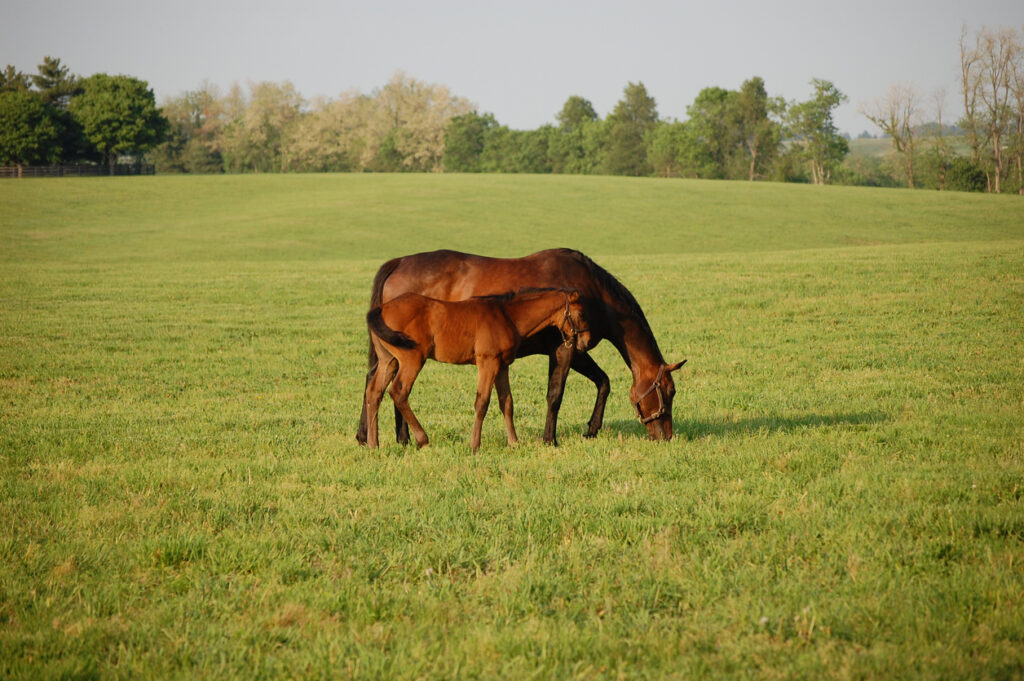If you’re new to breeding or even if you’ve been around the track a few times, you’ve likely been told that the sire line is where it’s at.
After all, the name recognition, race records, and market appeal seem to follow the big-name stallions.
But here’s the truth no one talks about enough: the dam, or the female horse, contributes just as much to a foal’s potential. Ignoring her, or undervaluing her role, is like only reading half the book and expecting to understand the full story.
Let’s break it down and, more importantly, show you exactly how to use the dam line to your advantage.

Dams Contribute 50% of Genetics—Don’t Forget It
It sounds obvious, but you’d be surprised how many breeders overlook this basic fact: the dam provides half of the foal’s genetic makeup.
In a world where the marketing machine of the sire dominates, this gets lost in the noise. But think about it—what does 50% mean?
It means that the mare has just as much impact on the foal’s physical traits, temperament, and ability as the stallion does.
When you focus solely on the sire, you’re potentially throwing away half of your foal’s potential. Ask yourself, would you invest in stocks knowing you were only getting half the picture?
Here’s what to do next: Make a list of key traits you want in your foal (e.g., stamina, conformation, mental toughness). Then, look at both parents, not just the sire.
Is the dam contributing the qualities that complement what the stallion offers? If not, it’s time to rethink.

Look at the Dam’s Offspring—Her Breeding Past Tells a Story
The dam’s previous offspring are like a cheat sheet for what she brings to the table.
If you don’t check her track record as a producer, you’re flying blind. Every horse is more than just its individual ability; its genetic legacy matters.
A mare’s ability to produce winning offspring speaks volumes about her genetic influence. For example, if you’re looking at a mare who consistently produces foals with speed but short stamina, and you’re breeding for longer races, that’s a clue.
Similarly, if she’s thrown multiple foals with conformational flaws, you’re taking a gamble hoping your foal will be the exception.
Here’s how to dig into this: Pull the racing records and sales results of her previous offspring. Are they excelling in the areas you care about?
If not, it’s a red flag. Breeding is a data-driven game, so treat it like one—analyze before you act.

Complementary Traits Are the Key—Not Just Race Records
Sure, race records can tell you a lot, but they’re only part of the puzzle.
The best breeders know that it’s not just about what the dam has done on the track; it’s about what traits she passes on and how those complement the stallion’s traits. A stallion might have blazing speed, but if the dam can add stamina and soundness, you’ve got a winning combination.
For example, if you’re breeding a fast, lightweight stallion, pairing him with a mare known for producing solid, durable offspring can balance out the traits and give you a stronger foal overall. The goal isn’t to duplicate the sire—it’s to create something better by leveraging both sides.
Here’s what you can do today: Make a side-by-side comparison of the dam and sire. Don’t just look at what they’ve won; compare their physical characteristics, temperaments, and even health history.
Find where they complement each other to avoid producing a foal with both parents’ weaknesses.

The Dam Line Is as Critical as the Sire Line—Here’s Why
Many breeders fall into the trap of thinking that a fancy sire line is enough.
It’s not. The dam line, which traces the maternal ancestry, is just as important, if not more so, in determining long-term breeding success.
Here’s the kicker: The mare is not just passing on her genetics but also contributing mitochondrial DNA, which plays a crucial role in energy production and overall vitality. So while the sire’s flashy record might catch your eye, the dam line is quietly doing the heavy lifting in areas that affect durability, soundness, and even mental resilience.
Consider this: some of the most successful racehorses in history come from strong maternal lines—lines known for producing winners, generation after generation. If you ignore this, you’re leaving valuable insights on the table.
To make smart breeding decisions, study the maternal family tree. Which sires and dams have worked well together in the past?
History tends to repeat itself in breeding.

Putting It All Together—Your Breeding Action Plan
By now, you should see that focusing only on the sire is a risky, one-dimensional strategy.
To breed successfully, you need to take the dam’s influence into account and examine her as critically as you would a stallion.
Here’s how you can start applying this today:
- Create a Dam Profile: For every mare you’re considering, create a detailed profile that includes her racing history, her offspring’s performance, and her physical and temperamental traits.
- Analyze Offspring Data: Look at the racing and sales records of her previous foals. Identify patterns—does she consistently pass on certain traits? Do her foals perform better at certain distances or in particular conditions?
- Match for Complementary Traits: Compare the dam’s strengths and weaknesses with those of the stallion. Is the dam compensating for the stallion’s shortcomings? Does the pairing improve the chances of a balanced foal?
- Research the Dam Line: Don’t just stop at the mare herself. Look into her dam and granddam’s production records. Are you seeing a strong pattern of success? If so, you’ve got a line worth investing in.
- Don’t Rely on Fame: A big-name sire might help with sales, but it won’t guarantee long-term success on the track. Let the dam’s genetics, history, and the broader dam line guide your decision-making.
When you start giving the dam the attention she deserves, you’ll be making smarter breeding decisions that lead to better results—not just at the auction, but on the racetrack too. So, the next time you’re drawn in by a big-name stallion, pause and think about the other half of the equation.
The dam might just be your secret weapon to breeding a champion.
Now, get to work—you’ve got some mares to evaluate.







Recent Comments